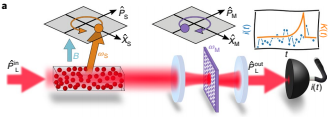
Theory section
The theory section of QUANTOP supports ongoing experiments and sets new goals for future projects. Central topics include:
- quantum limits for sensing
- quantum backaction evasion
- quantum noise evasion in gravitational wave detectors
- macroscopic entanglement generation and quantum teleportation
- quantum transduction
Quantum mechanics dictates that it is impossible to simultaneously have exact knowledge of two physical observables represented by non-commuting operators, e.g., the position and momentum of a microscopic particle or even a macroscopic mechanical object.
This circumstance is enforced by the presence of quantum noise, in particular manifesting itself as quantum backaction (QBA) noise on a material object when probed, e.g., by light or microwaves.
Quantum noise results in fundamental sensitivity limits on a variety of sensing tasks. These limits can be attained by exploiting the concept of a negative-mass reference frame [1]. In this way, the QBA on a macroscopic mechanical oscillator can be evaded using a polarized spin ensemble as the negative-mass auxiliary [2].

Hybrid spin-optomechanical system in which a joint measurement of the spin (S) and mechanical (M) systems realizes quantum backaction cancellation. This allows for measurement of the mechanical motion in the negative-mass reference frame provided by the spin system. It also allows for the generation of quantum entanglement between the two subsystems.
The ability to reduce (or, ideally, completely evade) the quantum noise associated with the probing of a system is key to quantum sensing tasks such as force and position sensing beyond the standard quantum limit [3], and essential quantum networking protocols such as entanglement generation between remote systems [4]. The latter was realized using the macroscopic spin-optomechanical system in QUANTOP’s Hybrid lab [5].
The research has particular focus is on the advantages (and challenges) of using hybrid quantum systems, e.g., spin-optomechanical systems where an atomic spin ensemble is combined with either tabletop optomechanical systems (as realized in QUANTOP’s Hybrid lab) or a large-scale gravitational wave detector such as LIGO (proof-of-principle experiment underway in QUANTOP’s Gravitational Wave lab [correct denomination?]).
As another example, electro-optomechanical systems offer the capability of quantum transduction [6] of, e.g., microwave signals to the optical domain via an intermediary mechanical mode [7].
Sensitive optical detection of classical radio-frequency signals using an electro-optomechanical system was demonstrated in QUANTOP’s lab [8].
Quantum transduction is an essential ingredient in various hybrid quantum network protocols [9], which require bridging the gap between the disparate operating frequencies of its various components.
Researchers
- Oliver Sandberg (PhD student)
- Emil Zeuthen (Assistant Professor)
References
- Polzik, E.S. and Hammerer, K., Trajectories without quantum uncertainties. Annalen der Physik 527: A15-A20 (2015). https://doi.org/10.1002/andp.201400099
- Møller et al., Quantum back-action-evading measurement of motion in a negative mass reference frame. Nature 547, 191–195 (2017). https://doi.org/10.1038/nature22980
- Zeuthen et al., Gravitational wave detection beyond the standard quantum limit using a negative-mass spin system and virtual rigidity. Rev. D 100, 062004 (2019). https://doi.org/10.1103/PhysRevD.100.062004
- Xuang et al., Unconditional steady-state entanglement in macroscopic hybrid systems by coherent noise cancellation. Rev. Lett. 121, 103602 (2018). https://doi.org/10.1103/PhysRevLett.121.103602
- Thomas et al, Entanglement between Distant Macroscopic Mechanical and Spin Systems. arXiv:2003.11310 [quant-ph]; to appear in Nature Physics. https://arxiv.org/abs/2003.11310
- Zeuthen et al., Electrooptomechanical equivalent circuits for quantum transduction. Rev. Applied 10, 044036 (2018). https://doi.org/10.1103/PhysRevApplied.10.044036
- Wu et al., Microwave-to-Optical Transduction Using a Mechanical Supermode for Coupling Piezoelectric and Optomechanical Resonators. Rev. Applied 13, 014027 (2020). https://doi.org/10.1103/PhysRevApplied.13.014027
- Bagci et al., Optical detection of radio waves through a nanomechanical transducer. Nature 507, 81–85 (2014). https://doi.org/10.1038/nature13029
- Zeuthen et al., Figures of merit for quantum transducers. Quantum Sci. Technol. 5 034009 (2020). https://doi.org/10.1088/2058-9565/ab8962
